Bibliometric and PESTEL Analysis of Deep-Sea Mining: Trends and Challenges for Sustainable Development
Abstract
1. Introduction
2. Theoretical Framework
2.1. Description of Strategic Deep-Sea Resources
2.1.1. Polymetallic Nodules
2.1.2. Ferromanganese Crusts
2.1.3. Seafloor Massive Sulfides (SMS)
2.2. Assessment of Potential Impacts Generated by DSM
3. Methodology
3.1. Database and Document Selection
3.2. PESTEL Analysis
3.3. Bibliometric Analysis
3.3.1. Research Methods
- Co-authorship analysis: This method examines collaboration among authors, which occurs when two or more researchers co-author a document [36]. It allows for the identification of collaboration patterns (academic, institutional, or national) and the analysis of scientific communities within a research field.
- Co-occurrence analysis: Based on keyword co-occurrence, this method identifies the frequency with which related terms appear together in the literature, thereby revealing key thematic areas [37].
- Bibliographic coupling: This technique links documents that share common references. If two articles appear together in the reference list of a third, their similarity can be measured based on the number of shared citations [38]. This method helps to uncover connections between documents with overlapping bibliographic foundations.
3.3.2. Visualization of Bibliometric Analysis
4. Results and Discussion
4.1. PESTEL Analysis
4.2. Bibliometric Analysis
4.2.1. Co-Authorship Bibliometric Analysis
- Red Cluster: It comprises nine authors, including Jones, Smith, and Simon Lledó, and mainly focuses on the environmental dimension, particularly on the impact of DSM on benthic communities. It also incorporates the technological dimension, related to the development and application of spatial data analysis tools.
- Yellow Cluster: It is composed of eight authors, such as Vanreusel and Haeckel, and focuses on environmental issues concerning marine benthic biodiversity and ecosystem recovery.
- Blue Cluster: It includes eight authors, like Dahlgren, Glover, and Wiklund, and is linked to environmental research, especially ecological, taxonomic, and genetic studies of deep-sea organisms.
- Purple Cluster: It comprises eight authors, including Clark, Rowden, and Levin, and this group focuses on environmental themes such as habitat conservation and mitigation strategies. It also indirectly touches on political and legal dimensions by contributing to governance and regulatory frameworks. Notably, the links in this cluster are thicker, indicating stronger and more frequent collaborations.
- Green Cluster: It is formed by eight authors, including Durden, Jaeckel, and Gjerde, and this cluster addresses the environmental, legal, and political dimensions, particularly governance, regulation, and sustainability policies for mitigating DSM’s ecological impacts.
- Light Blue Cluster: It consists of five authors, including Sweetman and Stratmann, and this group combines the environmental and technological dimensions, focusing on modeling DSM impacts in vulnerable ecosystems, carbon cycle disruptions, and the resilience of benthic communities.
- Orange Cluster: It is composed of four authors, such as Gooday and Pawlowski, and focuses on environmental themes related to protist biodiversity and monitoring changes caused by DSM. Their work provides crucial input for the sustainable management of seabed ecosystems.
- Brown Cluster: It contains two authors, Van Dover and Mestre, and focuses on environmental issues, particularly the balance between exploitation and conservation. They also propose mitigation and habitat restoration strategies and indirectly address political dimensions by advocating for precautionary approaches and sustainable practices in DSM management.
- Pink Cluster: It is composed of two authors, notably Lily and Craik, who address sustainability challenges in DSM, focusing mainly on political and legal issues, such as environmental risks and the gaps in governance frameworks necessary for responsible exploitation.
4.2.2. Co-Citation Bibliometric Analysis
- The red cluster is focused on documents related to the impacts of DSM on deep-sea ecosystems, damage assessments, and mitigation strategies regarding the impacts generated by mining activities.
- The purple cluster centers on the intersection between ecological impacts and regulatory implications.
- The blue cluster is related to emerging technologies and marine resource exploration.
- The yellow cluster is associated with the economic potential of seabed resources as well as the advancements needed for DSM exploration.
- Finally, the green cluster relates to the implementation of regulations overseen by the ISA, the regulation of exploration under the framework of the United Nations Convention on the Law of the Sea (UNCLOS), and governance issues concerning environmental projection.
4.2.3. Author Keyword Co-Occurrence Analysis
- The green cluster is centered on DSM-related topics as the main axis as well as concepts such as Environmental Impact Assessments (EIA) and the Common Heritage of Mankind.
- The red cluster is related to environmental impacts and their ecological dimension.
- The blue cluster covers aspects of exploration and numerical simulations used to model impacts and different processes related to DSM. It also includes the blue economy, linked to the exploration of marine resources with responsible economic growth.
- The yellow cluster is associated with seabed resources such as polymetallic nodules.
- The purple cluster relates to resources of hydrothermal origin, such as hydrothermal vents.
- Finally, the light blue cluster is linked to topics on governance, sponsoring states, and DSM regulation.
4.2.4. Bibliographic Coupling Analysis
- The red cluster groups the initial and pioneering studies on DSM, focused on seabed resources.
- The light blue cluster explores emerging technologies related to seabed extraction, where the connections are stronger—evidenced by the thickness of the network lines—which indicates a significant amount of shared bibliographic bases.
- The green cluster addresses more environmental and ecological topics.
- The yellow cluster encompasses issues related to regulation and legal frameworks surrounding DSM.
- The blue cluster includes more recent technological developments.
- Finally, the purple cluster focuses on environmental impacts and mitigation strategies in DSM resource extraction and also shows a higher degree of interconnection between the works—similar to what is observed in the light blue cluster.
5. Conclusions
Author Contributions
Funding
Data Availability Statement
Conflicts of Interest
References
- Ramirez-Llodra, E.; Trannum, H.C.; Evenset, A.; Levin, L.A.; Andersson, M.; Finne, T.E.; Hilario, A.; Flem, B.; Christensen, G.; Schaanning, M.; et al. Submarine and deep-sea mine tailing placements: A review of current practices, environmental issues, natural analogs and knowledge gaps in Norway and internationally. Mar. Pollut. Bull. 2015, 97, 13–35. [Google Scholar] [CrossRef]
- Hein, J.R.; Mizell, K.; Koschinsky, A.; Conrad, T.A. Deep-ocean mineral deposits as a source of critical metals for high- and green-technology applications: Comparison with land-based resources. Ore Geol. Rev. 2013, 51, 1–14. [Google Scholar] [CrossRef]
- Mudd, G.M.; Jowitt, S.M. Growing Global Copper Resources, Reserves and Production: Discovery Is Not the Only Control on Supply. Econ. Geol. 2018, 113, 1235–1267. [Google Scholar] [CrossRef]
- Beaulieu, S.E.; Graedel, T.E.; Hannington, M.D. Should we mine the deep seafloor? Earth’s Future 2017, 5, 655–658. [Google Scholar] [CrossRef]
- Hannington, M.; Jamieson, J.; Monecke, T.; Petersen, S.; Beaulieu, S. The abundance of seafloor massive sulfide deposits. Geology 2011, 39, 1155–1158. [Google Scholar] [CrossRef]
- Delivorias, A. Norway to Mine Part of the Arctic Seabed; European Parliamentary Research Service: Brussels, Belgium, 2024. [Google Scholar]
- Cormier, R.; Londsdale, J. Risk assessment for deep sea mining: An overview of risk. Mar. Policy 2020, 114, 103485. [Google Scholar] [CrossRef]
- Levin, L.A.; Amon, D.J.; Lily, H. Challenges to the sustainability of deep-seabed mining. Nat. Sustain. 2020, 3, 784–794. [Google Scholar] [CrossRef]
- Roth, R. Update on Financial Payment systems: Seabed Mining for Polymetallic Nodules. Environ. Resour. Econ. 2018, 17, 395–408. [Google Scholar] [CrossRef]
- De Sousa, G.C.; Castañeda-Ayarza, J.A. PESTEL analysis and the macro-environmental factors that influence the development of the electric and hybrid vehicles industry in Brazil. Case Stud. Transp. Policy 2022, 10, 686–699. [Google Scholar] [CrossRef]
- Chen, C. Science Mapping: A Systematic Review of the Literature. J. Data Inf. Sci. 2017, 2, 1–40. [Google Scholar] [CrossRef]
- Miller, K.A.; Thompson, K.F.; Johnston, P.; Santillo, D. An Overview of Seabed Mining Including the Current State of Development, Environmental Impacts, and Knowledge Gaps. Front. Mar. Sci. 2018, 4, 418. [Google Scholar] [CrossRef]
- Marino, E.; Blasco, I.; Blanco, L.; González, F.J.; Somoza, L.; Medialdea, T. Llega la Era de la Minería Submarina; Ilustre Colegio Oficial de Geologos: Madrid, Spain, 2017. [Google Scholar] [CrossRef]
- Hein, J.R.; Spinardi, F.; Okamoto, N.; Mizell, K.; Thorburn, D.; Tawake, A. Critical metals in manganese nodules from the Cook Islands EEZ, abundances and distributions. Ore Geol. Rev. 2015, 68, 97–116. [Google Scholar] [CrossRef]
- Petersen, S.; Krätschell, A.; Augustin, N.; Jamieson, J.; Hein, J.R.; Hannington, M.D. News from the seabed—Geological characteristics and resource potential of deep-sea mineral resources. Mar. Policy 2016, 70, 175–187. [Google Scholar] [CrossRef]
- Toro, N.; Jeldres, R.I.; Órdenes, J.A.; Robles, P.; Navarra, A. Manganese Nodules in Chile, an Alternative for the Production of Co and Mn in the Future—A Review. Minerals 2020, 10, 674. [Google Scholar] [CrossRef]
- Hein, J.R.; Conrad, T.A.; Dunham, R.E. Seamount Characteristics and Mine-Site Model Applied to Exploration- and Mining-Lease-Block Selection for Cobalt-Rich Ferromanganese Crusts. Mar. Georesour. Geotechnol. 2009, 27, 160–176. [Google Scholar] [CrossRef]
- Gollner, S.; Kaiser, S.; Menzel, L.; Jones, D.O.; Brown, A.; Mestre, N.C.; Van Oevelen, D.; Menot, L.; Colaço, A.; Canals, M.; et al. Resilience of benthic deep-sea fauna to mining activities. Mar. Environ. Res. 2017, 129, 76–101. [Google Scholar] [CrossRef]
- Halbach, P.; Marchig, V.; Scherhag, C. Regional variations in Mn, Ni, Cu, and Co of ferromanganese nodules from a basin in the Southeast Pacific. Mar. Geol. 1980, 38, M1–M9. [Google Scholar] [CrossRef]
- Morgan, M. Comparison of vaginal misoprostol and gemeprost as pre-treatment in first trimester pregnancy interruption. BJOG 2000, 107, 145–146. [Google Scholar] [CrossRef]
- Hein, J.R.; Koschinsky, A. Deep-Ocean Ferromanganese Crusts and Nodules. In Treatise on Geochemistry; Elsevier: Amsterdam, The Netherlands, 2014; pp. 273–291. [Google Scholar] [CrossRef]
- Baker, E.; Beaudoin, Y. Deep Sea Minerals: Cobalt-Rich Ferromanganese Crusts, a Physical, Biological, Environmental, and Technical Review; Secretariat of the Pacific Community: Noumea, New Caledonia, 2014. [Google Scholar]
- Hannington, M.D.; De Ronde, C.E.J.; Petersen, S. Sea-Floor Tectonics and Submarine Hydrothermal Systems. In One Hundredth Anniversary Volume; Society of Economic Geologists: Littleton, CO, USA, 2005. [Google Scholar] [CrossRef]
- Weaver, P.P.E.; Billett, D.S.M.; Van Dover, C.L. Environmental Risks of Deep-sea Mining. In Handbook on Marine Environment Protection; Salomon, M., Markus, T., Eds.; Springer International Publishing: Cham, Switzerland, 2018; pp. 215–245. [Google Scholar] [CrossRef]
- Van Dover, C.L.; German, C.R.; Speer, K.G.; Parson, L.M.; Vrijenhoek, R.C. Evolution and Biogeography of Deep-Sea Vent and Seep Invertebrates. Science 2002, 295, 1253–1257. [Google Scholar] [CrossRef]
- German, C.R.; Petersen, S.; Hannington, M.D. Hydrothermal exploration of mid-ocean ridges: Where might the largest sulfide deposits be forming? Chem. Geol. 2016, 420, 114–126. [Google Scholar] [CrossRef]
- Amon, D.J.; Ziegler, A.F.; Dahlgren, T.G.; Glover, A.G.; Goineau, A.; Gooday, A.J.; Wiklund, H.; Smith, C.R. Insights into the abundance and diversity of abyssal megafauna in a polymetallic-nodule region in the eastern Clarion-Clipperton Zone. Sci. Rep. 2016, 6, 30492. [Google Scholar] [CrossRef]
- Paulikas, D.; Katona, S.; Ilves, E.; Ali, S.H. Life cycle climate change impacts of producing battery metals from land ores versus deep-sea polymetallic nodules. J. Clean. Prod. 2020, 275, 123822. [Google Scholar] [CrossRef]
- Van Dover, C.L. Impacts of anthropogenic disturbances at deep-sea hydrothermal vent ecosystems: A review. Mar. Environ. Res. 2014, 102, 59–72. [Google Scholar] [CrossRef]
- Vonnahme, T.R.; Molari, M.; Janssen, F.; Wenzhöfer, F.; Haeckel, M.; Titschack, J.; Boetius, A. Effects of a deep-sea mining experiment on seafloor microbial communities and functions after 26 years. Sci. Adv. 2020, 6, eaaz5922. [Google Scholar] [CrossRef]
- Spearman, J.; Taylor, J.; Crossouard, N.; Cooper, A.; Turnbull, M.; Manning, A.; Lee, M.; Murton, B. Measurement and modelling of deep sea sediment plumes and implications for deep sea mining. Sci. Rep. 2020, 10, 5075. [Google Scholar] [CrossRef]
- Pranckutė, R. Web of Science (WoS) and Scopus: The Titans of Bibliographic Information in Today’s Academic World. Publications 2021, 9, 12. [Google Scholar] [CrossRef]
- Singh, V.K.; Singh, P.; Karmakar, M.; Leta, J.; Mayr, P. The journal coverage of Web of Science, Scopus and Dimensions: A comparative analysis. Scientometrics 2021, 126, 5113–5142. [Google Scholar] [CrossRef]
- Yüksel, İ. Developing a Multi-Criteria Decision Making Model for PESTEL Analysis. Int. J. Bus. Manag. 2012, 7, 52–66. [Google Scholar] [CrossRef]
- Moral-Muñoz, J.A.; Herrera-Viedma, E.; Santisteban-Espejo, A.; Cobo, M.J. Software tools for conducting bibliometric analysis in science: An up-to-date review. Prof. Información 2020, 29, e290103. [Google Scholar] [CrossRef]
- Biscaro, C.; Giupponi, C. Co-Authorship and Bibliographic Coupling Network Effects on Citations. PLoS ONE 2014, 9, e99502. [Google Scholar] [CrossRef]
- Galvez, C. Análisis de co-palabras aplicado a los artículos muy citados en Biblioteconomía y Ciencias de la Información (2007–2017). Transinformação 2018, 30, 277–286. [Google Scholar] [CrossRef]
- Boyack, K.W.; Klavans, R. Co-citation analysis; bibliographic coupling, and direct citation: Which citation approach represents the research front most accurately? J. Am. Soc. Inf. Sci. 2010, 61, 2389–2404. [Google Scholar] [CrossRef]
- Van Eck, N.; Waltman, L. Software survey: VOSviewer, a computer program for bibliometric mapping. Scientometrics 2010, 84, 523–538. [Google Scholar] [CrossRef]
- Kleiv, R.A.; Thornhill, M. Deep-Sea Mining—A Bibliometric Analysis of Research Focus, Publishing Structures, International and Inter-Institutional Cooperation. Minerals 2022, 12, 1383. [Google Scholar] [CrossRef]
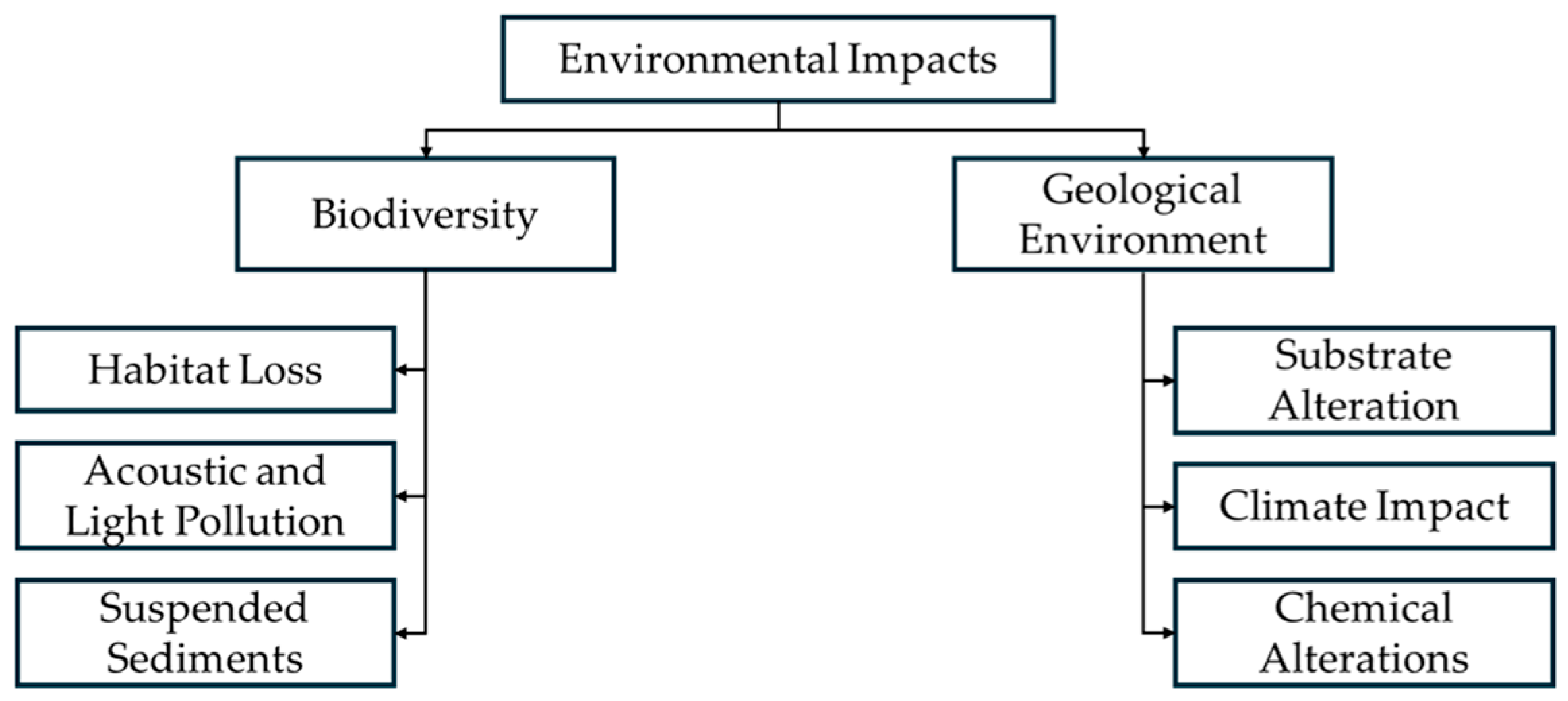
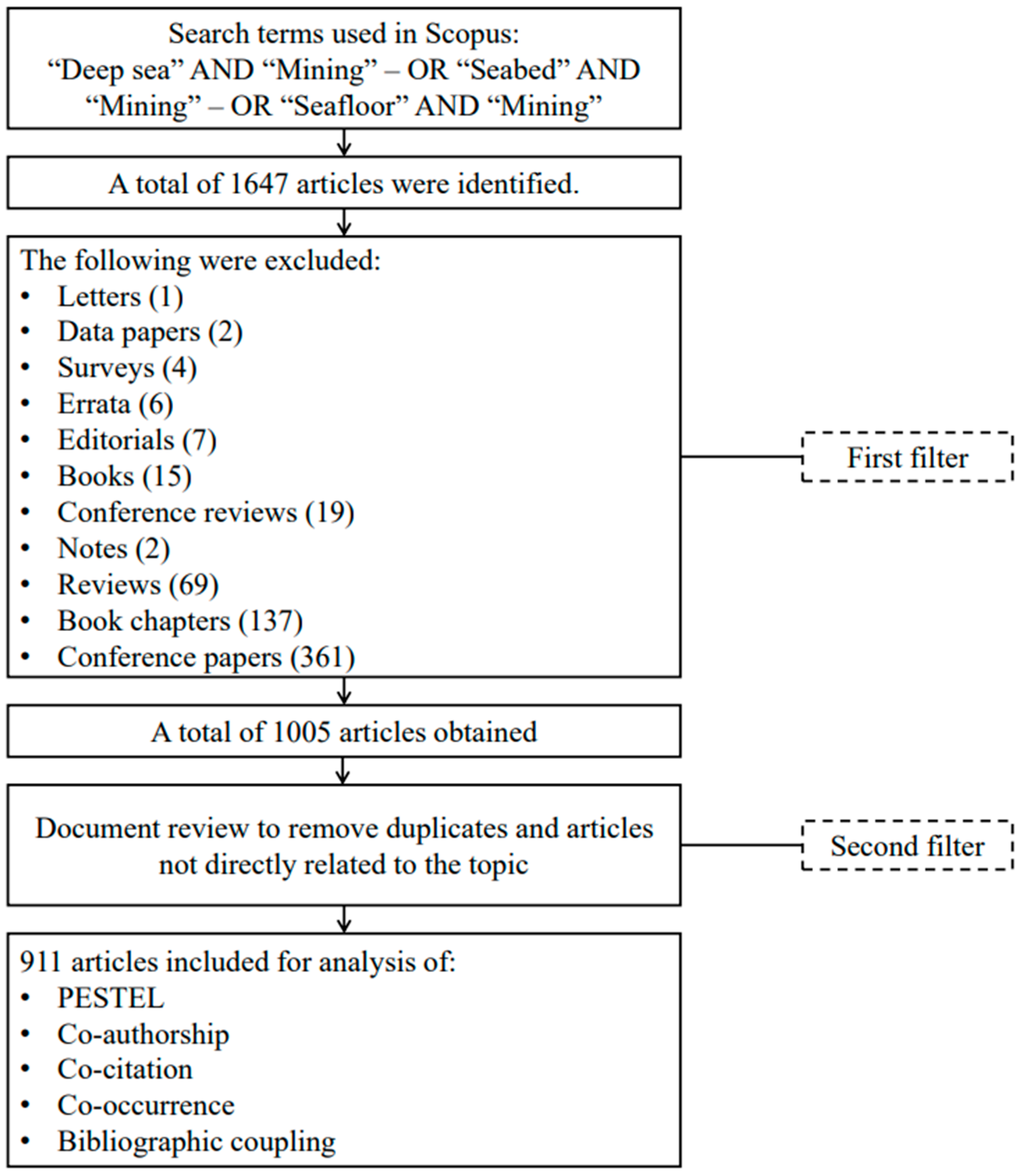
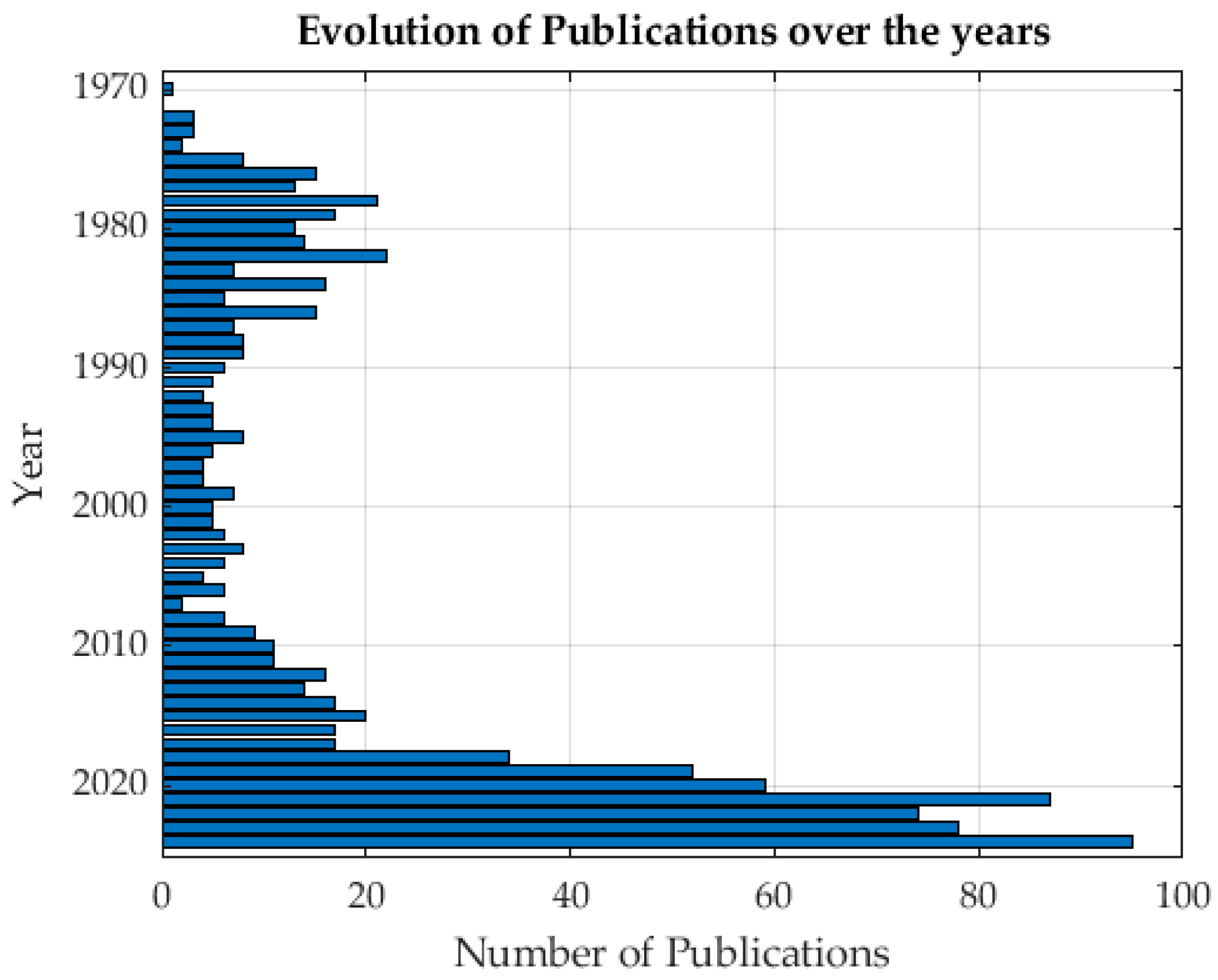

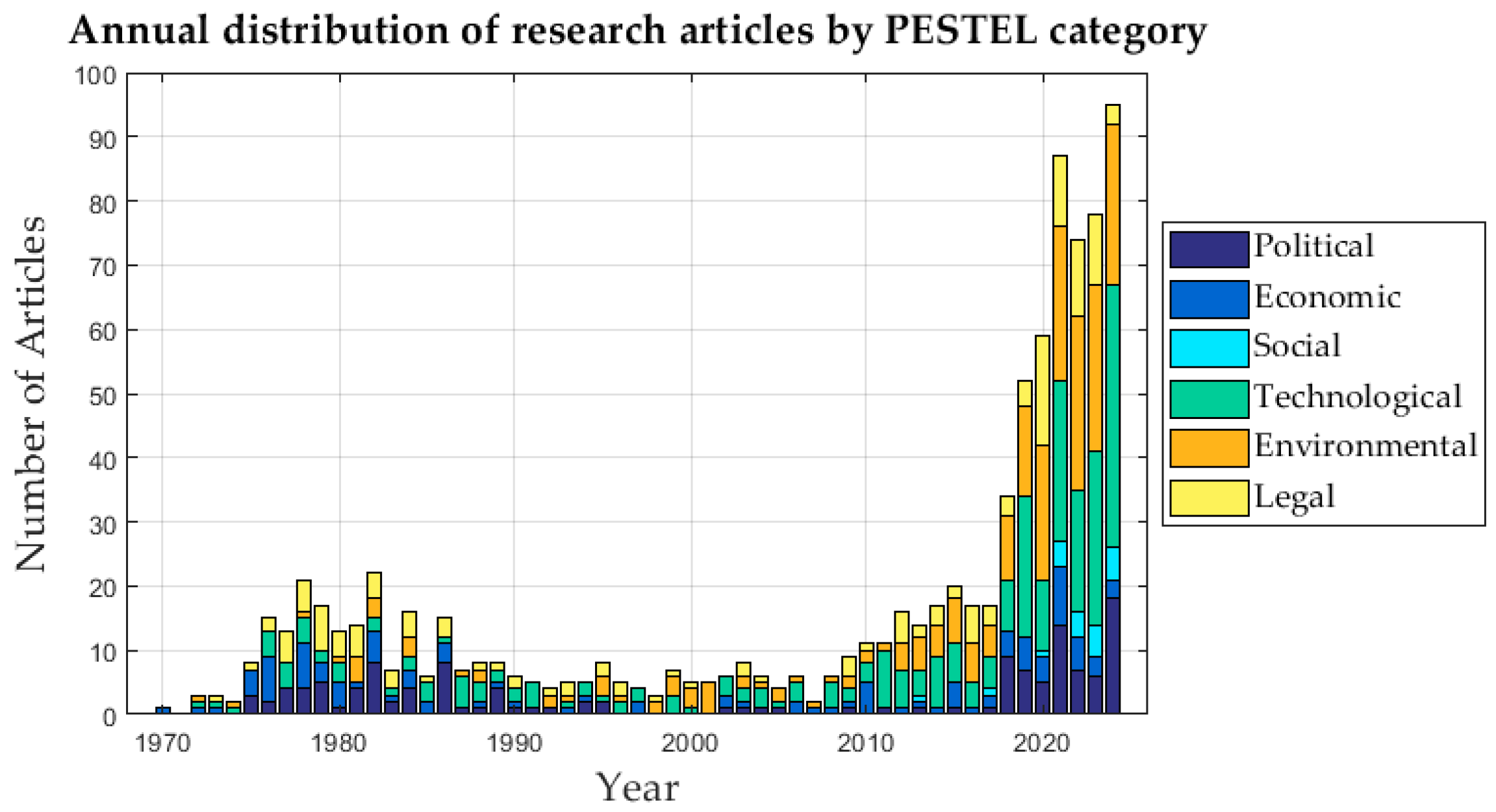

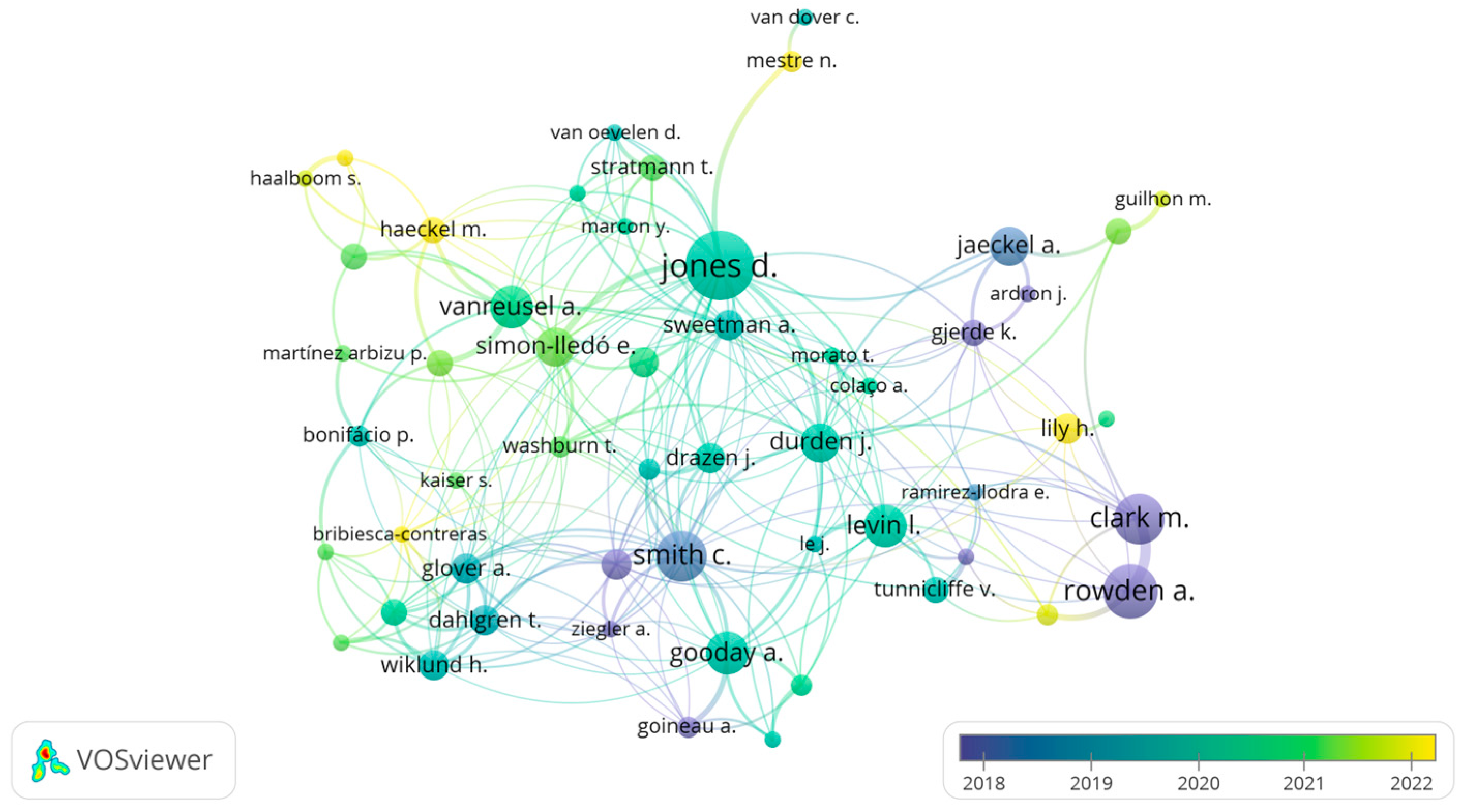
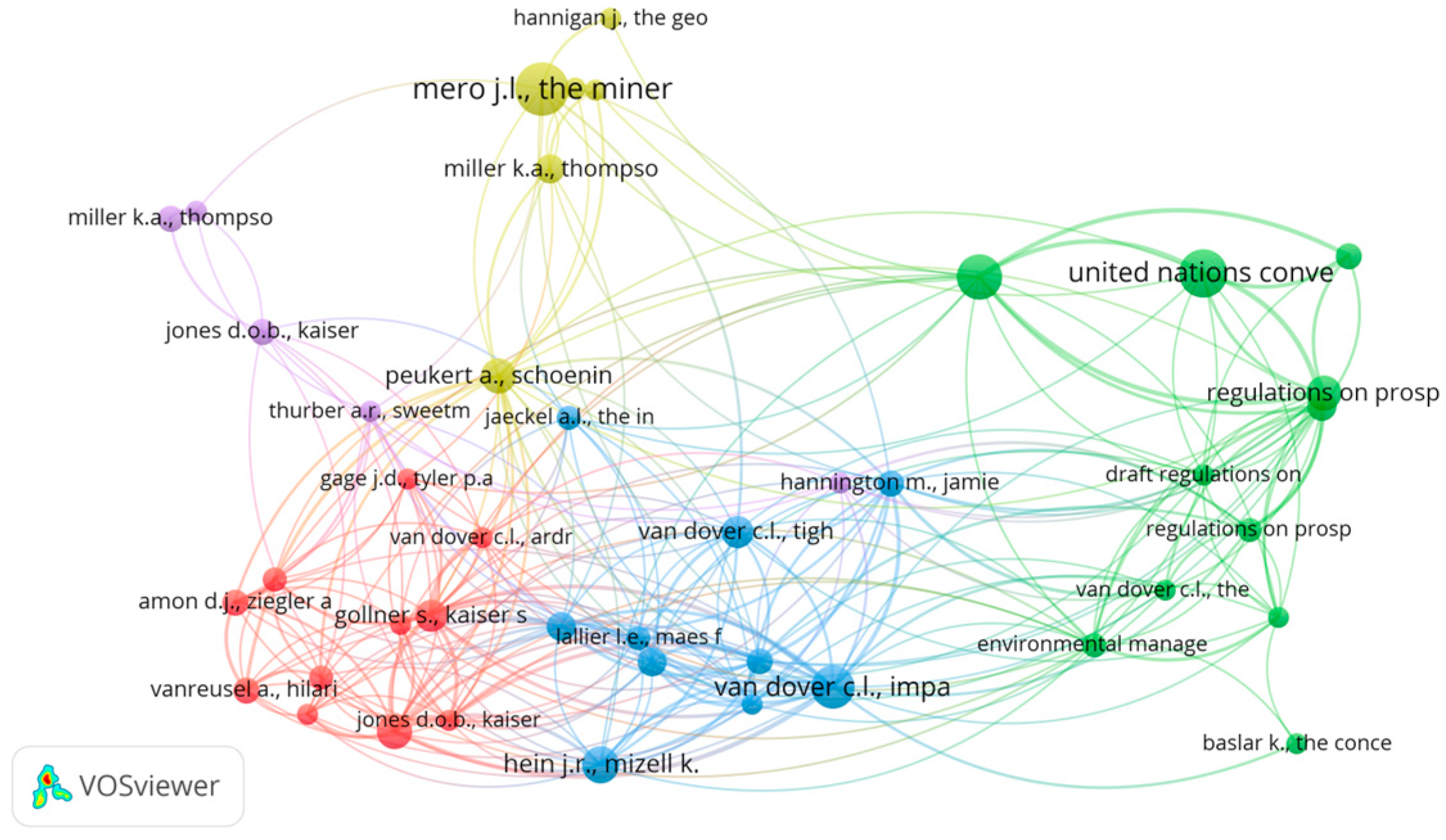
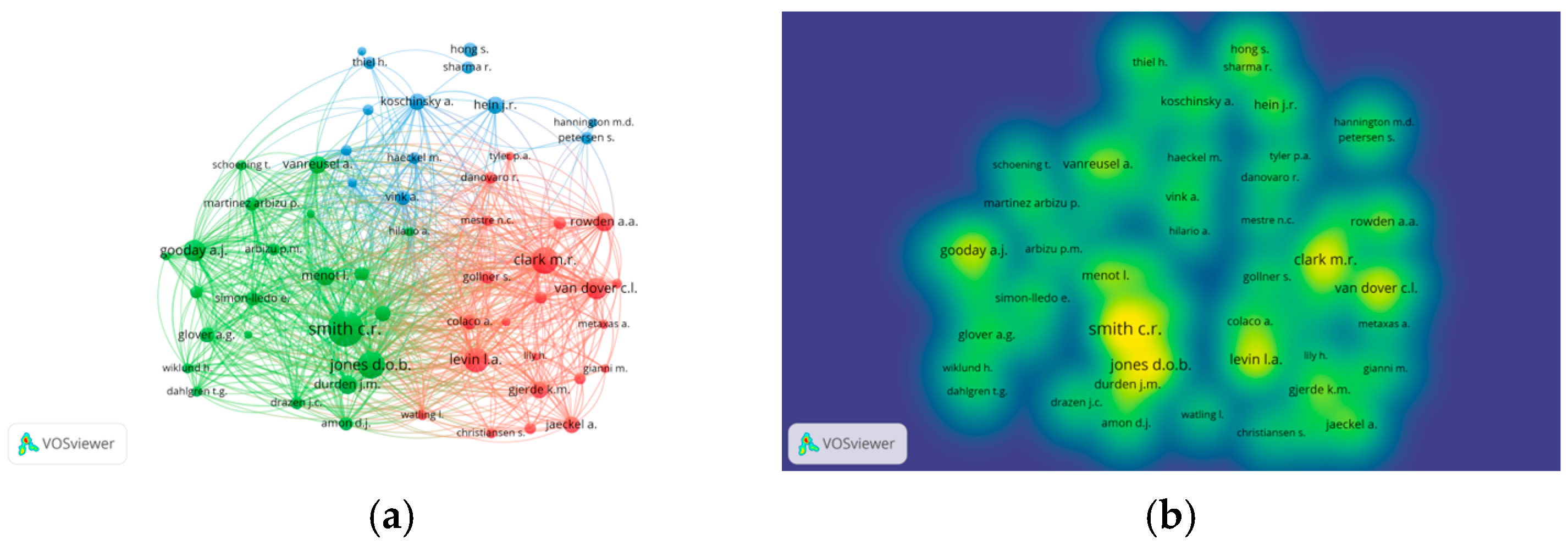

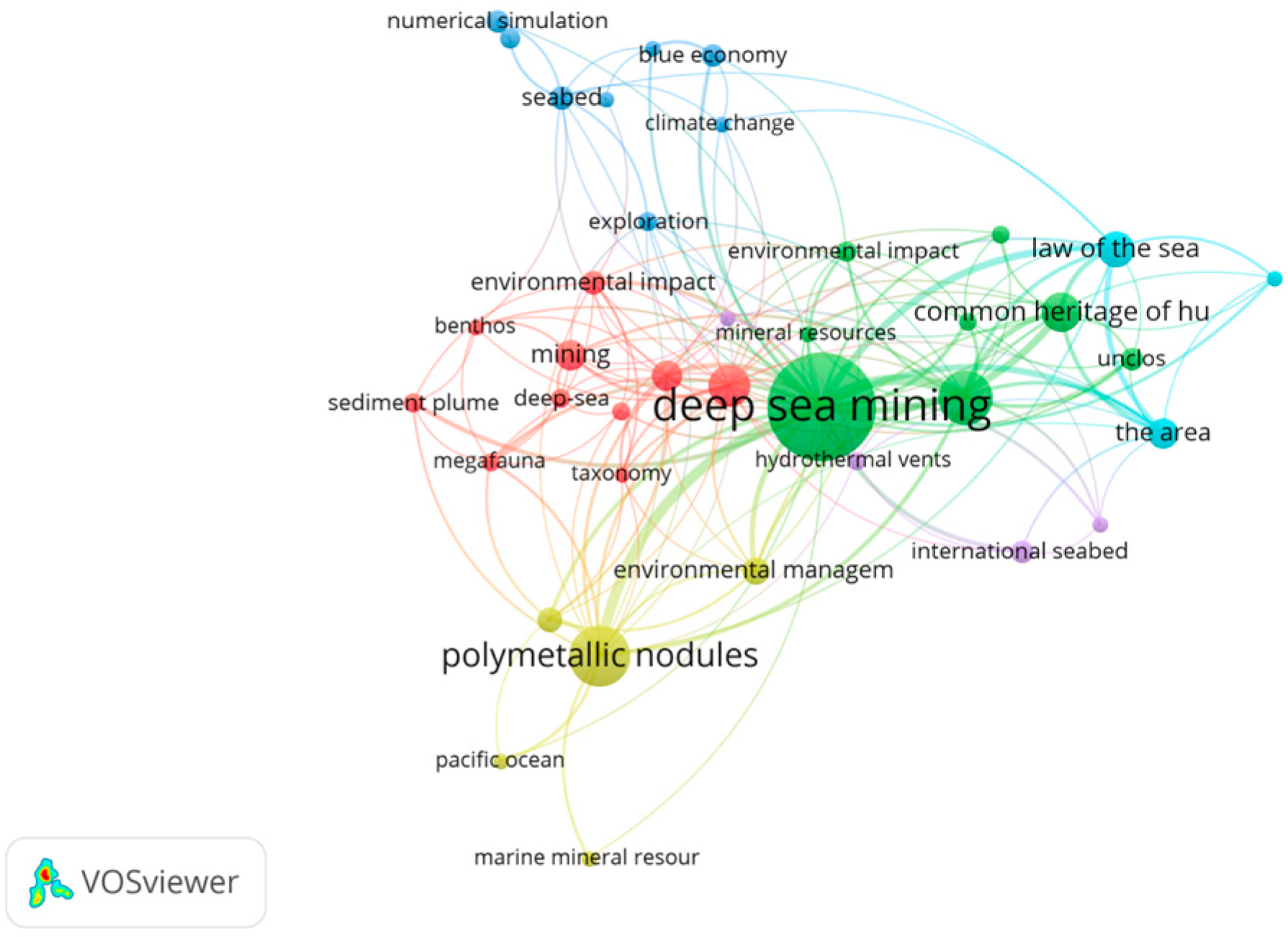
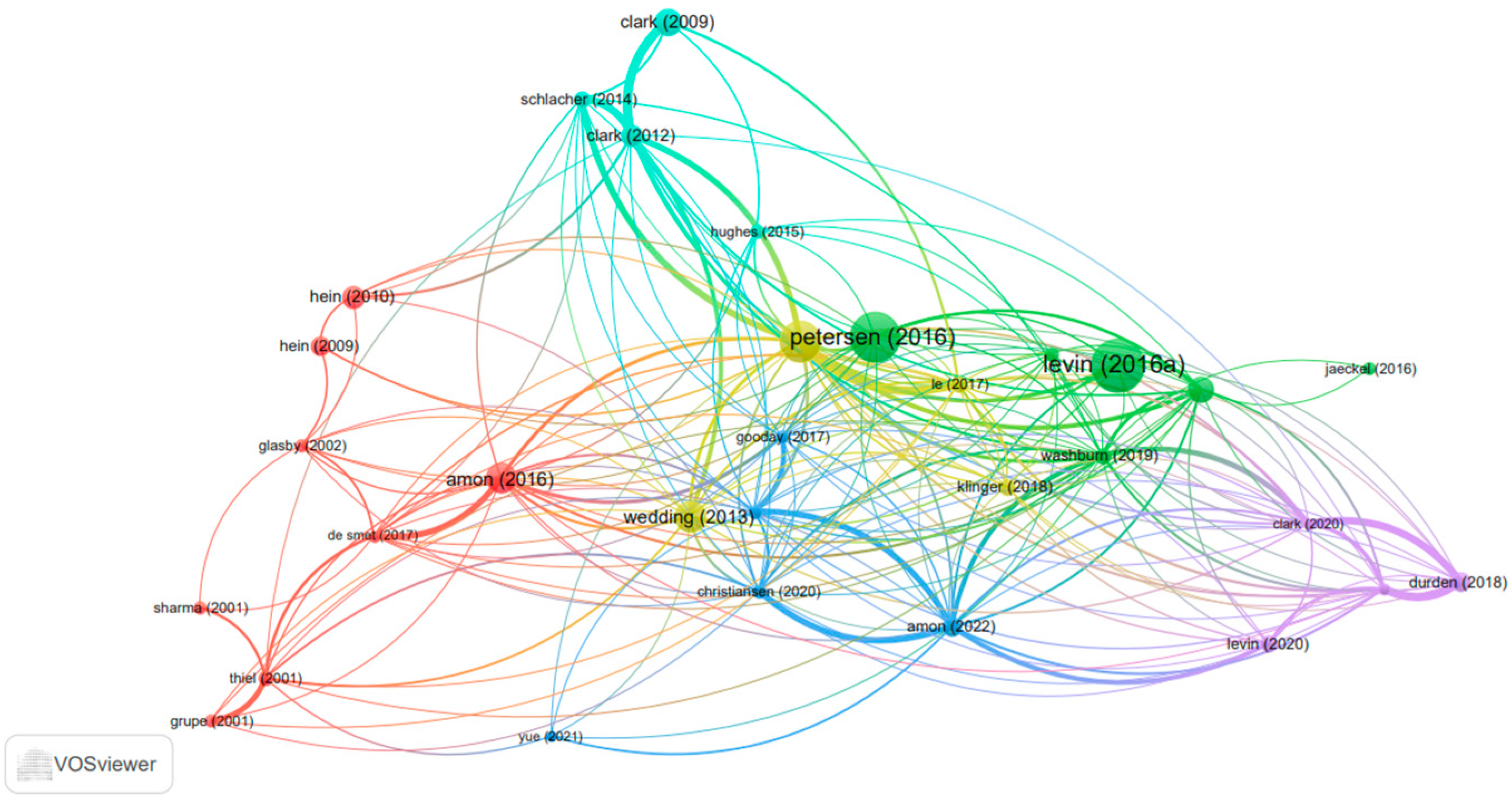
| Keyword | Occurrences | Total Link Strength |
|---|---|---|
| Deep sea mining | 215 | 237 |
| International seabed authority | 55 | 102 |
| Polymetallic nodules | 70 | 82 |
| Common heritage of mankind | 29 | 56 |
| Law of the sea | 25 | 55 |
| The area | 17 | 45 |
| Deep sea | 33 | 37 |
| Biodiversity | 18 | 34 |
| Environmental management | 14 | 27 |
| Clarion–Clipperton Zone | 12 | 24 |
Disclaimer/Publisher’s Note: The statements, opinions and data contained in all publications are solely those of the individual author(s) and contributor(s) and not of MDPI and/or the editor(s). MDPI and/or the editor(s) disclaim responsibility for any injury to people or property resulting from any ideas, methods, instructions or products referred to in the content. |
© 2025 by the authors. Licensee MDPI, Basel, Switzerland. This article is an open access article distributed under the terms and conditions of the Creative Commons Attribution (CC BY) license (https://creativecommons.org/licenses/by/4.0/).
Share and Cite
Espínola, F.; Castillo, E.; Orellana, L.F. Bibliometric and PESTEL Analysis of Deep-Sea Mining: Trends and Challenges for Sustainable Development. Mining 2025, 5, 36. https://doi.org/10.3390/mining5020036
Espínola F, Castillo E, Orellana LF. Bibliometric and PESTEL Analysis of Deep-Sea Mining: Trends and Challenges for Sustainable Development. Mining. 2025; 5(2):36. https://doi.org/10.3390/mining5020036
Chicago/Turabian StyleEspínola, Fernanda, Emilio Castillo, and Luis Felipe Orellana. 2025. "Bibliometric and PESTEL Analysis of Deep-Sea Mining: Trends and Challenges for Sustainable Development" Mining 5, no. 2: 36. https://doi.org/10.3390/mining5020036
APA StyleEspínola, F., Castillo, E., & Orellana, L. F. (2025). Bibliometric and PESTEL Analysis of Deep-Sea Mining: Trends and Challenges for Sustainable Development. Mining, 5(2), 36. https://doi.org/10.3390/mining5020036






